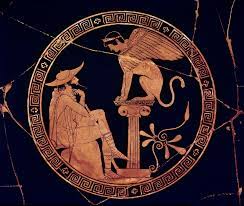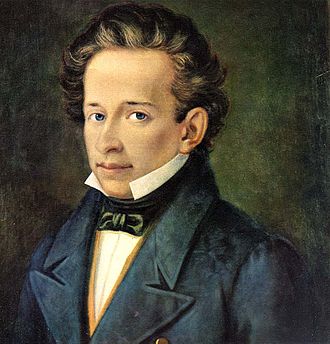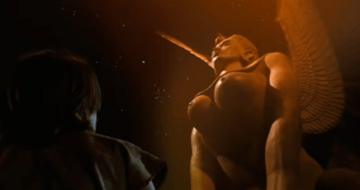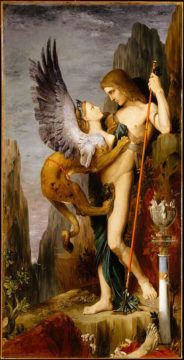by Ada Bronowski

The encounter between Oedipus and the Sphinx has always represented the encounter between two incompatible worlds: chaos versus reason, myth versus history, woman against man, enigmatic verbosity against crystal-clear clarity. Only one of these worlds can survive the clash.
The Sphinx’s riddle: what stays the same yet walks on four feet in the morning, two at midday and three in the evening, is solved by Oedipus who says that it is man, who crawls on all four as a baby, walks on two feet in his prime and with the aid of a stick, and thus on three legs, in his old-age. With this answer, Oedipus came to his own not as Oedipus, the individual, but as a figure of modern man, dispelling the forces of darkness that reigned terror on helpless mortals. Overcoming the Sphinx was – it seemed – like a new beginning, in which man-made laws became the one true law, and wild nature was tamed by human rationality.
As the Sphinx threw itself off a cliff, it buried with it the unwieldly, monstrous side of nature, and Oedipus was hailed not as ‘one amongst the gods’ as so often with Greek heroes, but ‘as a mortal, first amongst men, who disarmed the supernatural forces’, (at the beginning of Sophocles’ Oedipus the King, l.31-4). Of course, we know what happened next. Man-made law and order did not stand a chance in the face of parricide, incest and children that are also siblings. The dark forces soon took hold of Oedipus and of Thebes once more, to the extent that one suspects they never left in the first place.
Fate. Tragedy. Irony. Inevitability. All the woes that mark the human condition are inseparable from Oedipus’ thirst and capacity for knowledge. His victory over the Sphinx had set him apart as a superiorly reasoning man. He is a Platonist before Plato as he reveals what is one and immutable, Man himself, amidst an efflorescence of changing attributes (legs: two, three, four). And he is Aristotle before Aristotle – the philosopher who fixed for the following two thousand years or so, the rules of logical inference. For Oedipus will launch into a sequence of logical deductions which will lead him to the necessary conclusions that the murderer of Laïos, whom he is searching for, is no one other than himself and that Laïos is his father.
Oedipus is Plato and Aristotle in one, before they even existed – but we can see how tragedy leads to philosophy. Oedipus is the embodiment of philosophical enquiry: the reflective, dialectical, reasonable and earnest quest for truth and knowledge. But he is also the embodiment of the vanity of such an enterprise. The real answer, which he failed to give to the Sphinx is not universal Man, but the most particular, corrupt, twisted, vicious, helpless creature on the planet, namely himself, Oedipus, whose physical lameness makes him a man who never quite walks on two feet, wavering since childhood between two, three and four legs, and whose terrible actions make him all at once child, husband and old father at one and the same time. There is no Platonic universal man distinct from the messy contradictory description of a man’s life. And when Oedipus finally, logically deduces the truth, in contrast to Aristotle’s promise of the pleasure of knowledge, he cannot bear to look at it, but blinds himself.
Rather than the upward figure of modern emancipated man, Oedipus is the innocent-guilty unable to be responsible for his life, because mortals cannot ever truly be responsible for their lives. The Freudian reinterpretation of Oedipus as the man with the complex merely shifts the weight of the fated fall to an in-built perversion we are all supposed to harbour in more or less constrained forms.
But what if the encounter with the Sphinx did not end there, at the beginning so to speak of the Oedipean adventure? After all, the Sphinx wins at the end. And it must return for the spoils. Two worlds of wisdom met, fought one another, each with its own weapons, playing a long game in the case of the Sphinx, and human wisdom lost. But surely man should have, if not a second chance, at least a moment of reckoning, to at least give the Sphinx the true answer and by giving it, admit defeat.
Giacomo Leopardi (1798-1837), the Italian poet-philosopher (pictured) , often somewhat caricatured as the thinker of cosmic pessimism, conjures up just such a second meeting in one of his prose Moral Fables, ‘The Dialogue between Nature and an Icelander’ from 1824.
of cosmic pessimism, conjures up just such a second meeting in one of his prose Moral Fables, ‘The Dialogue between Nature and an Icelander’ from 1824.
In the middle of a desert where no human has ever been, a huge female figure, leaning against a mountain and perhaps herself half mountain, whose face is ‘half beautiful and half terrifying’ is met with a wanderer from Iceland who has fled all human society and is now running away from nature. ‘That is like a squirrel running away from a rattle snake’ answers the monstrous figure, because, she says, ‘I am the one you are running away from’. It is not immediately death at Samarra, but the encounter has the irony of fatality about it.
As the dialogue unfolds, the Icelander recaps the story of the world’s woes since Oedipus. Human society is not only corrupt, but its obsession with finding happiness decreases exponentially the possibility of ever getting close to it. There is no such thing as pleasure. The Icelander’s last recourse is to live in isolation from human society – just as Oedipus does in the last phase of his life, roaming the land, guided by faithful Antigone. But in his self-imposed exile, the Icelander realises that nature is far worse even than humans. Everywhere he goes, he suffers all the ignominies caused by natural phenomena: from volcanoes, to freezing winters, storms to wildfires. There is never a moment of peace in nature. Is there anywhere in the world where it is possible ‘by not offending, to not be offended, by not taking pleasure, to not suffer?’
It is the weight of the post-Oedipean fall that drives the Icelander to surmise that nature is punishing humanity for its pretentions. The two or three pages that describe, with touches of the sublime, disasters without end (flash floods, scorching heat waves, earthquakes, plagues, all so particularly resonant today) reconfigure, in terms of freak phenomena, the wild uncontrollable traits of the Sphinx. They are the material expressions of the power of the dark forces which Oedipus did not succeed in outwitting. The Icelander concludes that this Nature-Sphinx is the unremitting enemy of mankind. But having realised as much, he would like to understand why, why have invited human beings into this chaos that has no place for them?
This is where Leopardi manifests his genius and adumbrates a pre-Nietzschean path which, if it is bleak for the continuation of mankind, is also a victory of a different kind. For when Nature-Sphinx finally answers back, in this second historical encounter with man, after he has endured all that he can endure, the Sphinx imparts the truth. Real knowledge: the dream of man.

The answer is disappointing – as all momentous answers invariably are. It is that Nature is utterly indifferent to humanity, inchoately traversed by forces of production and destruction. The big secret is that there is no enemy. The chaos human reason had set itself up to destroy, is a figment of reason’s imagination.
Leopardi seemingly takes up the modern view of his times about the mechanistic processes of nature. But in confronting the Icelander’s recriminations with the terse detachment of Nature-Sphinx, it is less the materialistic sciences that he presents than the absurdity of the Icelander’s undertaking. An absurdity which Leopardi belabours by reigniting the etymological origin of the word ab-surdity, from the Latin ‘surdus’, deaf. Nature-Sphinx is deaf to the pleas of man. The joke is on humanity, for entering into a dialogue with the deaf.
Is this cosmic pessimism? Only insofar as it is a radical pessimism which denies the merest seeds of consolation. Leopardi is not saying the worst is yet to come, he is saying the worst was, is and will be. What we realise is not only the insignificance of man, not only his ridiculous pretention to control nature but also his irrelevance. It is a lesson too harsh to accept in its rawness: ‘existence is an imperfection, an irregularity, a monstrosity’, he writes in a note from his Zibaldone[1]. But there is also a pathetic side to such conclusions. A comic effect akin to that ‘other kind of laughter’ Plato speaks of in the Republic, (Bk 7, 518a-b): the absurd laughter provoked by the philosopher who has had a taste of real knowledge, and is plunged back into the darkness of the cave where he is fumbling about, looking ridiculous. It is a wrong, a wry sort of laughter, but it is all we can do to not succomb to complete despair.
The Icelander, as a new Oedipus, is like that fumbling philosopher: he has experienced all that one can, and heard the truth from the mouth of the Sphinx, and yet he remains a pathetic figure in a comedy of knowledge. Even his death is a parody of a death. No one knows exactly what happened: whether two rickety lions ate him up, though ‘they barely had the strength to do so’, or did desert winds bury him under the sand, his mummified body found years later, and exhibited in some European museum?
The moral of the fable is clear: in his insignificance, man, whose thirst for knowledge leads him to the confines of uninhabited land, ends up as a museum exhibit in a fusty Europe which itself is destined to fossilise. But the sands and the winds and the lions who survive to see another day, are a promise of something else, that humanity won’t ever know.
This leaves humanity vacillating between a lucid and vertiginous stare into the abyss and an equally lucid acceptance of ever-renewed illusions of self-realisation. Leopardi considered himself a neo-classical writer resisting the Romantic movement of his times. His is an atheistic materialism that rejects the catholic Romanticism, which is the dominating literary force of the times, incarnated by the larger-than-life figure of Chateaubriand whose exaltation of nature is at the diametrical opposite from Leopardi. It is not surprising that Leopardi’s influence becomes more palpable later in the century, when Romanticism explodes into a decadent fin de siècle torn between a variety of artistic and intellectual movements which had at least one thing in common, that of moving away from the outpourings of the subjective eye and I.

The portrayal of Oedipus’s encounter with the Sphinx becomes symbolic of such a turning point in the long 19th century, when Gustave Moreau exhibits his version of it in Paris 1864 (pic.4). It inspired, some thirty years later, a poem by a figure who would later become the herald of a modernism characterised precisely in that it turned its back to the possibility of a (lugubrious) second chance with Nature-Sphinx.
The Greek Alexandrian poet Constantine Cavafy (1863-1933) wrote a poem in 1895 titled ‘Oedipus’, ‘written – we learn from the poem’s exergue – after reading a description of Gustave Moreau’s painting Oedipus and the Sphinx’. It is a piece from Cavafy’s juvenilia, which he himself vehemently disavowed (‘what rubbish’ he writes in a journal entry from January 1st, 1906). As the Greek poet and Nobel laureate Giorgos Seferis (1900-1971), described him, Cavafy was ‘a poet of old-age’[2], meaning not that Cavafy’s subject was caducity but rather that his freshness and originality came to bloom in his maturity.
But it is precisely what is un-Cavafyesque in Cavafy’s ‘Oedipus’ which plays a part in the tragedy of ignorance of the Oedipean knowledge-seeker, a figure of anti-Romantic pessimism.
The poem is a poem about a text about a painting. Cavafy is already at two-removes from the influence of sentiment. And though it is not known for sure which text Cavafy is referring to, chances are it is the short description Gustave Moreau himself gives of his work: ‘Travelling at the merciless and mysterious point of his life, man meets the eternal enigma that oppresses and destroys him’[3].
Moreau already deviates from the tragic fate of Oedipus, by elevating his situation to a universal and indeed metaphysical level. His Oedipus is an anti-Dante, caught not ‘in the middle of the path of our life’ (with the hope for a better future), but on his way downwards. And it is not by chance that Dante had become an emblem of Romanticism from Byron to Delacroix, when Oedipus is transfigured into that of the Symbolists. Moreau’s Oedipus is seen as a figure of humanity whose fate is to be confronted with a puzzle it cannot solve.
Cavafy makes palpable this tension in his poem. Oedipus, with all his certainty of defeating the Sphinx – for now – rather than look at the monster, gripping at his chest, is staring into a future which is both in and beyond time. He has
‘A premonition which is crystal clear in his soul
That there [n.a.: at the end of the path] the Sphinx will talk to him again
With much harder and more momentous
Enigmas, which no one can answer.’[4]
A future conversation awaits, after all the horrors that Oedipus is as yet ignorant of. The bleakness of the prospect sets out the grounds for a pessimism which is ambivalent between the certainty that the worst is yet to come and at the same time, that there is something new lurking in a future after the fall – a future which is absolutely beyond our grasp. The unanswerable enigma is unanswerable by Oedipus and by humanity at large, but the Sphinx’s living on, means that life in all its unfathomable monstrosity continues.

Cavafy succeeds in capturing something that he will in his later poems systematically deflect: that there is something more terrible awaiting, and it is something we are incapable of overcoming. For in the poems of his maturity, Cavafy overturns the order of calamity: the worst already happened, and we are here merely to live out the aftermath of the disaster of the past.
So, when the people – then or now? – flock to the main town square, half in alarm, half in expectation and wait and wait and wait till nothing and no one comes, in the 1904 poem ‘Waiting for the Barbarians’, the great surprise is that there are no Barbarians left.
‘And now, what shall become of us without the Barbarians?
Those people were a kind of solution.’
With this not-even-disappointment, Cavafy manifests his unique signature, that of creating an atmosphere, hung as if in limbo, in which nothing extrinsic to the moment is of any significance and perhaps even exists: ‘It is in the work itself that I find rest from the work’, he writes in his poem ‘On Painting’. There is nothing beyond toil itself, to desire, to expect or even to learn from.
Knowledge and ignorance are left behind, stuck in a deadlock, abandoned as if useless to our modernity, each lost in the reflection of the other’s monstrosity. As Nietzsche anticipates, no one knows anymore – not even the participants – which is Oedipus and which is the Sphinx.
[1] In G.Leopardi, Pensieri di varia filosofia e di bella letteratura, vol. I. Ed. Giosuè Carducci. Florence: Successori Le Monnier, 1898, p.4174 consultable online, here.
[2] In G. Seferis ‘Cavafy and Eliot – A Comparison’ in D. Harvey, ed., The Mind and Art of Cavafy, Athens: Denis Harvey and Co.,1983, p.60-88.
[3] In P-L Matthieu, ed., L’assembleur de Rêves: écrits complets de Gustave Moreau , Frontfroide : Fata Morgana 1984, p.61. (my translation).
[4] Translations by the author, for the full poem, see here.
